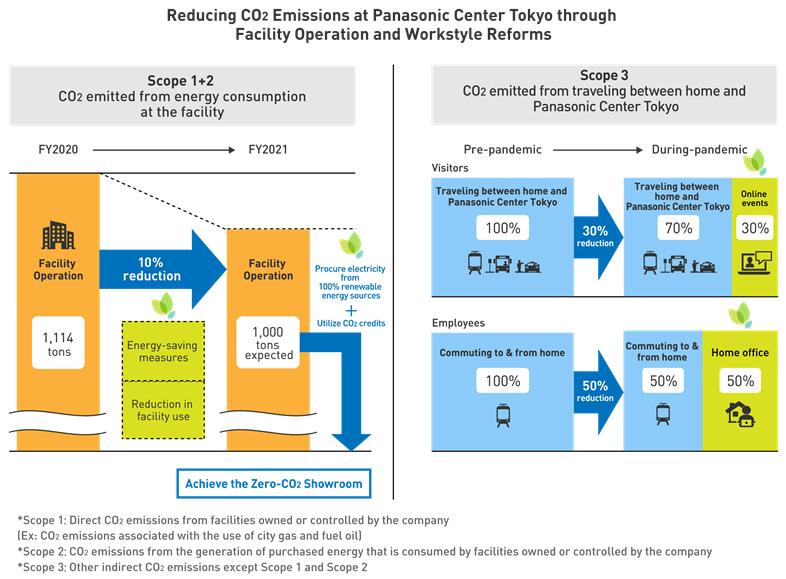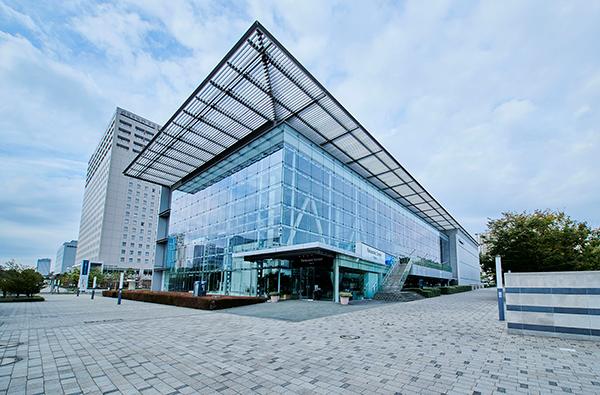Osaka, Japan – As part of its efforts to promote carbon neutrality, Panasonic Corporation has turned its flagship corporate showroom, the Panasonic Center Tokyo (PC Tokyo), carbon neutral*1. The facility in Tokyo’s Ariake area is the first non-manufacturing site for the company to achieve zero-carbon status*2.
In June 2017, Panasonic formulated a long-term vision for its environmental management—the Panasonic Environment Vision 2050. The vision seeks to achieve “a better life” and “a sustainable global environment,” while aiming to create a better, more comfortable society through clean energy. The company has been promoting various activities in anticipation of the year 2050 in line with this clear vision. As one example, it has been promoting businesses that contribute to sustainability, and working globally to create zero-CO2 factories. As of the end of the fiscal year ended March 2020 (FY2020), Panasonic had achieved zero CO2 emissions at four manufacturing sites (six factories). These zero-CO2 efforts have now been extended to Panasonic showrooms, and PC Tokyo is the first successful example.
Specifically, CO2 emissions at PC Tokyo in FY2021 are expected to be approximately 10% lower than the previous year.*3 This has been made possible by continuous energy-saving activities through the installation of energy-saving equipment, as well as reforms in management of on-site activities, which have included shifting seminars online, encouraging employees to work from home, and other workstyle reforms. The showroom also procures electricity made from 100% renewable energy, and uses CO2 credits to offset CO2 emissions generated from the use of fossil fuels. Moreover, as a site that makes use of hydrogen-based energy, which doesn’t emit CO2 when produced, the showroom will also facilitate demonstrations of Panasonic’s proprietary pure hydrogen fuel cells. To realize a hydrogen society in which people can live with peace of mind using clean energy, the showroom will seek to make effective use of the electricity and heat it generates.
Further, by moving showroom activities online, and actively promoting workstyle reform, PC Tokyo is working to reduce use of public transportation by showroom visitors and employees to reduce CO2 emissions in society.
By advancing activities like these on a global scale, Panasonic will steadily promote zero-CO2 manufacturing to achieve a sustainable society as outlined in the Panasonic Environment Vision 2050.
*1: It ensures zero CO2 emissions through energy-saving measures, and use of renewable energy and CO2 credits.
*2: As of November 2020, for all non-manufacturing sites at domestic and international Panasonic Group companies. The new zero-CO2 showroom will reduce CO2 emissions by approximately 1,114 tons.
*3: CO2 emissions at PC Tokyo: FY2020 approx. 1,114 tons; FY2021 (results and forecast) approx. 1,000 tons.
Specific initiatives to achieve zero CO2 emissions at PC Tokyo
(1) Continuous energy-saving activities through initiatives such as the installation of energy-saving equipment
- LED lighting: 60% of entire facility (installation period: 2018–2019)
- Thermal insulation film: 80% of entire facility (installation period: 2019–2020)
(2) Shifting all electricity procured to that made from 100% renewable energy
- Total shift from fossil fuel derived energy to biomass derived energy
(3) Use of J-Credit Scheme to offset CO2 emissions from fossil fuels
- CO2 emissions from community heating systems in the Tokyo waterfront area offset through the Japanese government’s J-Credit Scheme
(4) Reducing CO2 emissions through on-site management reform
- Seminars and events are being held online, and certain virtual showroom content has been made available to the public (this has reduced use of air conditioning and lighting equipment at on-site venues)
(5) Reducing CO2 emissions through employee workstyle reform
- The number of individuals working on-site is being brought down through reforms such as encouraging working from home (this has reduced the rate of operation of air conditioning and lighting equipment in offices and other showroom facilities)
(6) Demonstration of pure hydrogen fuel cells producing energy from hydrogen, which is attracting attention as a clean energy source
- Clean energy will be generated through installation of Panasonic’s proprietary pure hydrogen fuel cells (scheduled to begin operation in January 2021)

Media Contact:
Panasonic Corporation Brand Strategy Division Global Communications Office
https://news.panasonic.com/global/contacts/
About Panasonic
Panasonic Corporation is a worldwide leader in the development of diverse electronics technologies and solutions for customers in the consumer electronics, housing, automotive, and B2B businesses. The company, which celebrated its 100th anniversary in 2018, has expanded globally and now operates 528 subsidiaries and 72 associated companies worldwide, recording consolidated net sales of 7.49 trillion yen for the year ended March 31, 2020. Committed to pursuing new value through innovation across divisional lines, the company uses its technologies to create a better life and a better world for its customers. To learn more about Panasonic: https://www.panasonic.com/global.
Category: Exhibitions/Showrooms/Events Others – Business Field
Country: Japan



